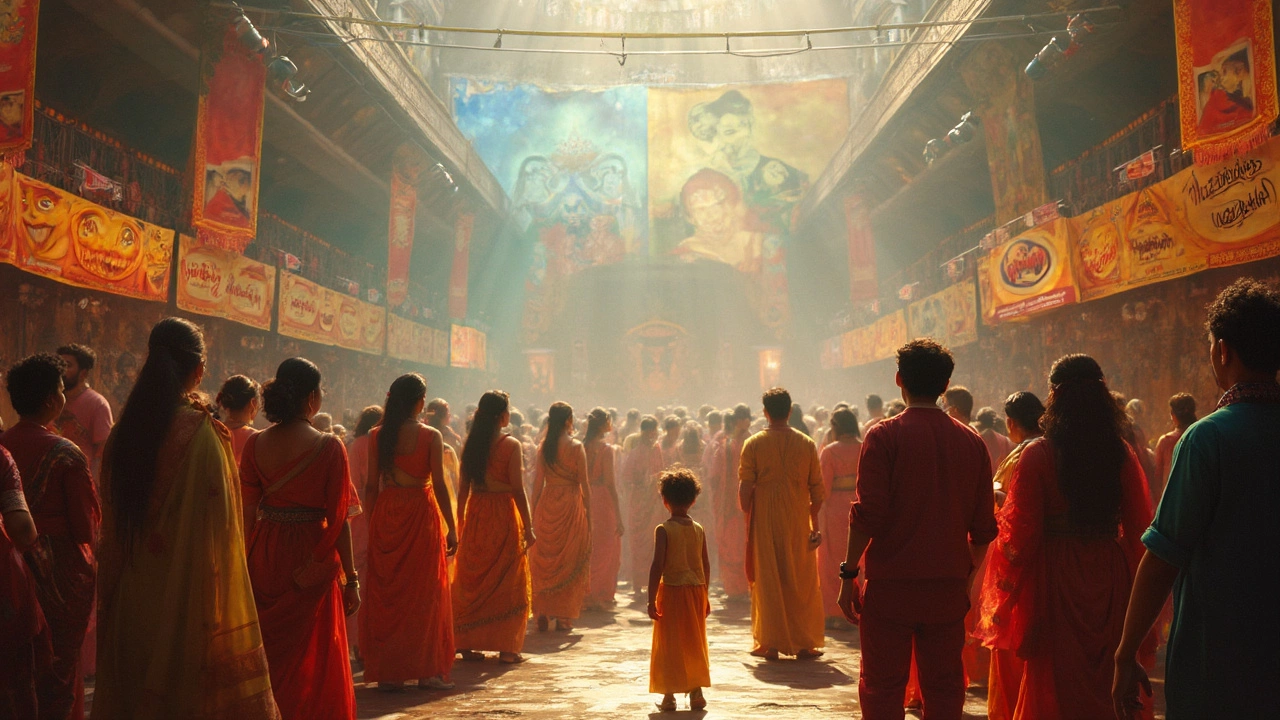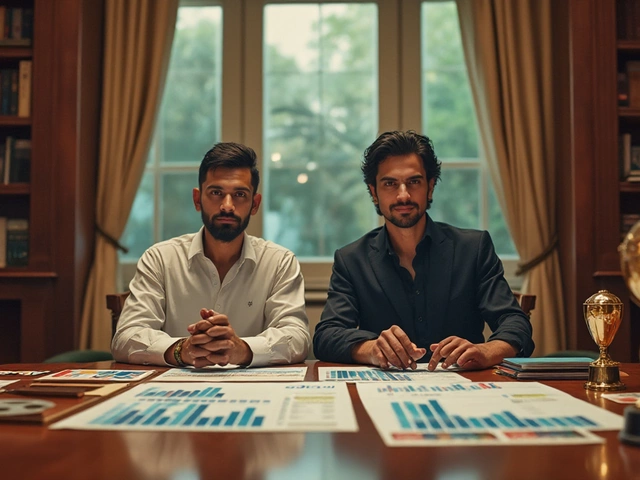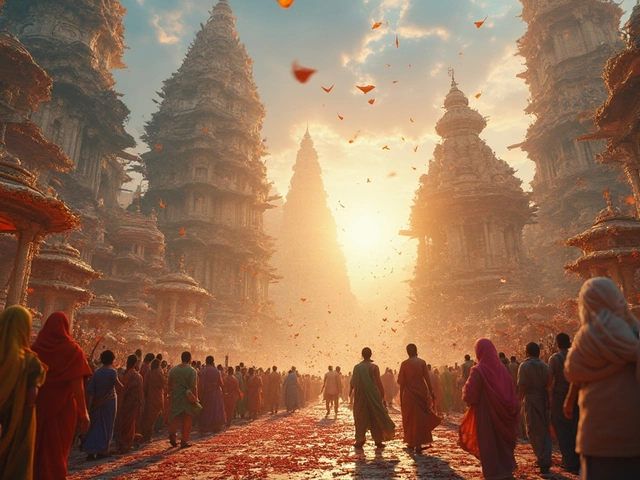
People keep asking whether RRR is a Tollywood or Bollywood movie. The confusion isn't surprising—almost every big Indian film these days seems to get released in multiple languages and all over the country. Fans argue online, and even some movie websites get it wrong. So, what's the real deal?
First things first: RRR was made in Telugu, produced by a team based in Hyderabad, and directed by S.S. Rajamouli, who's known for his Telugu blockbusters. That's why you'll hear film insiders and hardcore fans refer to it as a Tollywood film. But since it smashed box office records in Hindi too, and stars actors who often work in both industries, you can see where the mix-up starts.
It’s not just about language. These labels—‘Bollywood’ or ‘Tollywood’—come from the industry’s roots: the city, the original language, and the people who run the show behind the scenes. For kids like my son Arjun growing up on a diet of both Baahubali and Dangal, the boundaries are getting fuzzier every year. If you want to get your movie trivia right (and avoid embarrassing arguments), it helps to look at what goes into categorizing a movie like RRR in the first place.
- The Big Confusion: RRR's Identity
- Tollywood: More Than Just a Name
- Bollywood and the Hindi Dub Debate
- What Really Makes a Movie 'Belong'?
- How RRR Changed Industry Perceptions
- Tips for Exploring Indian Regional Films
The Big Confusion: RRR's Identity
If anyone tells you RRR is definitely a Bollywood film or swears it’s only Tollywood, they’re only half-right. This movie sparks more debates than a cricket match’s final over. Here’s why people still argue about it:
For starters, RRR was originally shot in Telugu. The director, S.S. Rajamouli, made his name in the Telugu film industry, Tollywood. Most of the crew and the big creative decisions came from Hyderabad—not Mumbai. That’s a firm sign it belongs to the Telugu world—aka Tollywood.
But here’s where it gets complicated. RRR didn’t just stick to the south. The producers spent a fortune dubbing and marketing it in Hindi, Tamil, Kannada, and Malayalam. In the north, it got released in massive Hindi versions, roping in actors like Alia Bhatt and Ajay Devgn, who are known for Bollywood. Thanks to streaming and cinema chains, this pushed RRR into Bollywood’s backyard and made the movie look like a national production.
Some big media outlets and casual fans call RRR a Bollywood hit simply because it did insanely well in Hindi. But that’s not totally accurate. Officially, it’s a Telugu film—everything from the director’s background, the studio (DVV Entertainment), and the language it was written in says so.
- The main cast—Ram Charan, Jr NTR, and director Rajamouli—are Tollywood powerhouses, not Mumbai regulars.
- The production company is based in the south, not in Mumbai, the home of Bollywood.
- The script was written in Telugu first, then dubbed and adapted for other markets.
If you want to geek out on the real identity of RRR, look beyond box office rankings and famous faces. It’s all about the roots: the core creative force. RRR is Tollywood at its core, even if it wore a Bollywood mask for fans across India.
Tollywood: More Than Just a Name
If you’ve always linked Tollywood with glitzy dance moves and larger-than-life heroes, you’re not wrong—but there’s more behind the name. Tollywood refers to the Telugu-language film industry, rooted mainly in Hyderabad. It’s one of the biggest movie industries in India, even rivaling Bollywood some years in sheer output and reach. The success of movies like RRR isn’t a fluke; Tollywood’s been delivering massive hits for decades.
Here’s something most folks miss: Tollywood isn’t just about language. It’s about the making, the studios, and the kind of stories people want to watch from that region. Studios like Ramoji Film City in Hyderabad aren’t just famous in India—they’re some of the largest studio complexes globally! Directors like S.S. Rajamouli and Trivikram Srinivas are household names in the South, and actors like Jr NTR and Ram Charan pull crowds far beyond Andhra Pradesh and Telangana.
To give you an idea of Tollywood’s scale, check out the box office data from recent years:
| Year | Tollywood Films Released | Estimated Box Office (Cr INR) |
|---|---|---|
| 2019 | 206 | 1,350 |
| 2022 | 213 | 2,600 |
| 2023 | 195 | 2,550 |
Why does this matter for RRR? Because its DNA is all Tollywood: Telugu script, Telugu actors in the lead, and original Telugu production management. The movie was dubbed and released simultaneously in Hindi, Tamil, Malayalam, and Kannada, but the first trailer, music launch, and marketing push happened in Telugu circles first.
If you’re curious how Tollywood pulls off movies at such a grand scale, here are a few things they do differently:
- Invest heavily in VFX and technology, sometimes even outpacing Hindi cinema.
- Cater to a very devoted fan base with hero-centric, high-energy stories.
- Release movies across South India (and even internationally) in dubbed versions right from day one.
So, next time someone calls RRR a Bollywood movie, you’ve got facts to clear up the confusion. Tollywood’s identity is strong, and films like RRR prove it’s much more than just a name.
Bollywood and the Hindi Dub Debate
Most folks outside South India first watched RRR in Hindi. That’s where a lot of confusion starts—some even think it’s a typical big-budget Bollywood flick. But here’s the lowdown: the movie was shot mainly in Telugu, then dubbed into Hindi and other languages to reach a massive audience.
Bollywood, by definition, focuses on movies originally made in Hindi, mostly produced out of Mumbai. RRR doesn’t fit that mold. It was never written or shot in Hindi first, and the main creative team comes from the Telugu industry. The RRR Hindi dub was a strategic move, given how big the audience for Hindi movies is across India (and even overseas in places like Dubai and Canada).
Let’s look at some numbers that put things in perspective:
| Language Version | Indian Box Office Gross (Crores) |
|---|---|
| Telugu | 276 |
| Hindi | 274 |
| Tamil & Others | 121 |
Pretty close race, right? The Hindi version made nearly as much as the Telugu original, but that still doesn’t make RRR a Bollywood movie. If you compare it to dubbed Hollywood movies—like Avatar or Avengers—those don’t suddenly become Bollywood or Tollywood when they’re dubbed. It’s the same thing here.
If you want to spot a dubbed film, check for obvious lip-sync mismatches or voice actors you’ve never heard before. Sometimes, there’s even a slightly different soundtrack or jokes adjusted for local flavor. But the story, main cast, and vision—all rooted in the Telugu original.
So next time someone gets into the RRR debate, drop this fact: the language you watched it in doesn’t decide its origin. It’s all about where and how it was originally made.

What Really Makes a Movie 'Belong'?
Ever argued over whether a film is Tollywood or Bollywood and realized nobody could settle it? This comes up a lot with movies like RRR. So, what actually pins a movie to a particular industry?
It mostly comes down to these factors:
- Language of production: If a movie is shot in Telugu first, it’s generally considered Tollywood. Same thing with Hindi and Bollywood. RRR was originally made in Telugu.
- Production base: Where the main production company is located matters. Tollywood mainly works out of Hyderabad, while Bollywood is Mumbai-centric.
- Creative team: Directors, writers, even composers—who’s calling the shots? With RRR, S.S. Rajamouli and composer M.M. Keeravani are both big in Tollywood.
- Main cast: Sometimes, star power blurs the lines. Both NTR Jr. (Tollywood) and Ajay Devgn (Bollywood regular) star in RRR, but the core cast is Telugu.
- Primary release market: If a movie is targeted at a Telugu-speaking audience first (with other dubs later), it leans Tollywood.
Now, streaming and pan-India releases make everything messier. Most blockbusters get dubbed in four or five languages and show up in theaters across the country. Some stats help drive home how much things changed after RRR’s release:
| Version | Box Office Share (%) | Original Cast Language |
|---|---|---|
| Telugu | 54 | Telugu |
| Hindi | 36 | Dubbed |
| Tamil/Malayalam/Kannada | 10 | Dubbed |
This shows where the real impact was—in Telugu-speaking regions. The numbers don’t lie.
So next time someone argues, check who made it, where it was made, and in what language. Bollywood and Tollywood labels still mean something, even in the days of pan-India movies. Being clear on this saves a lot of confusion, trust me—especially when you're chatting with movie geeks or arguing with family members at a get-together.
How RRR Changed Industry Perceptions
Before RRR hit the screens, people usually slotted Indian movies into neat boxes—Hindi films for Bollywood, Telugu for Tollywood, and so on. But RRR completely messed with these lines. It didn’t just appeal to folks in Andhra Pradesh and Telangana; it was a huge hit in Hindi-speaking regions, overseas, and even places where people have never watched Telugu films before.
Here’s what stands out: RRR set box office records in multiple languages. On its opening weekend in 2022, it raked in over ₹400 crore worldwide. That kind of cross-country, cross-language craze was mostly reserved for big Hindi movies earlier. Take a look at the numbers:
| Language | Release Format | India Box Office (₹ crore) |
|---|---|---|
| Telugu | Original | 350+ |
| Hindi | Dubbed | 250+ |
| Tamil, Kannada, Malayalam | Dubbed | 75+ |
With dubbed versions doing nearly as well as the original in some regions, producers now see Telugu movies as pan-Indian, not just regional. It’s gotten so official that streaming platforms like Netflix and ZEE5 make sure new releases drop in multiple Indian languages on day one.
Directors from the so-called ‘regional’ industries aren’t waiting for Bollywood’s stamp of approval anymore. A senior critic from Film Companion said it best:
“RRR proved that good storytelling and spectacle are bigger than language. Bollywood doesn’t have a monopoly on nationwide hits anymore.”Rajamouli himself predicted that soon there won’t be ‘regional’ and ‘Hindi’ movies—just Indian movies watched by everyone.
This movie has even changed what stories are being made. Studios aren’t afraid to spend big on stories beyond Hindi-speaking heroes, and actors are doing pan-Indian promotions. For anyone tracking RRR or wanting to catch the next big crossover hit, it’s clear: Indian cinema just got a lot less divided and a whole lot bigger.
Tips for Exploring Indian Regional Films
Getting started with Indian regional films can be overwhelming, especially if all you know is Bollywood. There are more than 20 different film industries in India, and each has its own flavor—think Tollywood (Telugu), Kollywood (Tamil), Mollywood (Malayalam), and Sandalwood (Kannada), just to name a few. In recent years, Telugu cinema (where RRR comes from) has exploded in popularity outside its home state.
If you’re curious about branching out, here’s how you can have a real experience—not just watch a movie, but get what’s special about it:
- Dive into Subtitles: Most big regional films, like RRR or Drishyam, are available on major streaming platforms with subtitles. Don't worry about missing out due to language barriers—many Indian families, including mine, happily watch movies together in Hindi, Telugu, or Tamil with subtitles switched on.
- Start With Crowd Favorites: Search for “top-rated” lists in every language. For example, ‘Baahubali’ (Telugu), ‘KGF’ (Kannada), and ‘Vikram’ (Tamil) changed the game for their industries. These are the breakout films everybody talks about, and for good reason.
- Notice the Local Touch: When you watch, keep an eye on little things like costumes, festivals, food, and slang. These clues show you what matters in each region. After watching Malayalam movies, you’ll recognize their love for subtle humor and natural scenery every time.
- Explore Streaming Apps: JioCinema, Hotstar, and Amazon Prime Video all have sections for regional movies. Netflix added a filter option in India in 2023 for language search—super handy when you want to try something new.
- Follow Regional Stars: Ram Charan, Jr NTR (Tollywood), Fahadh Faasil (Malayalam), Yash (Kannada), and Vijay Sethupathi (Tamil) are carving national fanbases. Movies led by them often trend worldwide.
Here's a quick table of where you’ll find some of India’s most popular film languages and industries:
| Industry | Language | Home City/Region | Recent Hit |
|---|---|---|---|
| Tollywood | Telugu | Hyderabad, Andhra & Telangana | RRR |
| Bollywood | Hindi | Mumbai | Pathaan |
| Kollywood | Tamil | Chennai, Tamil Nadu | Jailer |
| Mollywood | Malayalam | Kochi, Kerala | 2018 |
| Sandalwood | Kannada | Bangalore, Karnataka | KGF Chapter 2 |
Still not sure where to begin? As Komal Nahta, a well-known Bollywood trade analyst, once said,
“Great cinema always travels. Whether you understand the language or not, the emotion finds its way to you.”
The coolest part: you’re not alone if you get hooked. Regional films are getting English subtitles faster, and some, like RRR, landed in top global trends. Give them a shot—you might just find your new favorite binge.





Write a comment